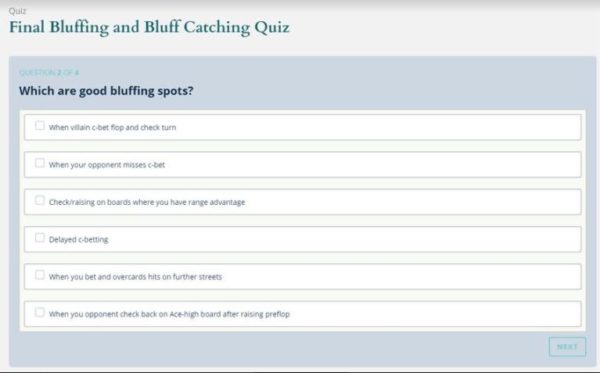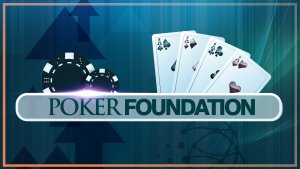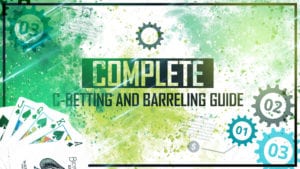In this day and age, playing online poker and being able to do so profitably has become quite a challenge. The skill level of an average opponent has dramatically improved, so “printing money” is no longer an option like it was some years ago.
These days, if you want to become good at poker and keep your win rates high, you need to put in the work and actually improve your game. That’s easier said and done, though, with so many different aspects to consider and so many game varieties on the table.
That’s where My Poker Coaching’s Formula For Success comes in handy. This video series, by my fellow Cardplayer Lifestyle contributor Tadas Peckaitis, covers a wide array of topics broken down into different segments, leading you one step at the time. I’ve actually already covered several segments from this course but in this comprehensive review, we’ll take a look into all of its individual components, referring you to the parts already analyzed, so you get the full picture of what you’re getting for your money. Speaking of money, I’m only going to mention the course’s cost at the end of this review. By the time you get there, you’ll realize it’s a bargain!
Start at the Beginning: Preparation for Poker Success
Not everyone looking for poker coaching is already well-versed with the intricacies of the game. That’s why it is nice to see that Tadas’ course starts at the very beginning, preparing even someone completely new to the game to become a successful player. Of course, there are many elements required to get started on the right foot, but the Preparation for Poker Success course covers a lot of ground.
Choosing Your Game
The first topic discussed is selecting your game type, namely whether you want to play cash games or tournaments. In the approximately half-hour-long video, Tadas discusses the benefits of both, from the freedom, lower variance, and table selection opportunities provided by the cash games, to the excitement and big winning opportunities offered by multi-table tournaments (MTTs). Another format covered by the video are the increasingly popular Jackpot Tournaments, primarily Spin & Go’s on PokerStars.

While it may take a little while to figure out exactly what poker format is best-suited for you and your style of play, some of the pros and cons laid out in this video should give you pretty good insights, especially if you’re new to poker. Of course, you may change your mind along the way, but this helps give you an idea of what format you should probably start with.
Where to Play
Another topic the video covers is the process of choosing the online poker room to play at. This decision is based primarily on the selection of your primary game. A room that’s great for a cash game player might be close to horrible for an MTT player. Tadas goes on to elaborate how to pick your room based on your game of choice, how to take advantage of bonuses, rakeback programs, tournament schedule, player traffic, etc.
Extras
In addition to the video, this course also contains course materials with the guides for picking the best poker software, links to the best poker sites and bonus offers, and a PDF that should serve as your guide for the rest of the course. There’s also a quiz to test what you’ve learned up until this point.
Continuing Your Journey: Poker Foundations
The next part of the course is called Poker Foundations and it tackles some of poker’s more abstract topics, if you will. The Poker Foundations video tackles matters of mental game, GTO strategy, and the overall approach to the game that is required if you want to achieve a long-term success.
Mental Game
In the Mental Game section of the video, Tadas covers several important topics, such as trying to identify your goals and then setting them up in a realistic way in terms of what you want to do and how long it will take you to get there. This is an important aspect that many players, even the more experienced ones, struggle with, because it is in our nature to set goals too high, which inevitably leads to disappointment. He also emphasizes that a poker player should never set specific monetary goals because poker’s financial fluctuations are highly dependent on variance, especially in the short run.
The video goes on to discuss how you should prepare for your sessions and how you need to stay in control of your emotions and avoid tilt. It gives some hands-on advice to recognize and battle tilt and distractions while playing and highlights when it might be best to cut your losses and quit a session.
GTO & Planning
The second part of the video deals mostly with GTO (Game Theory Optimal) strategy. This is the term often thrown around poker forums and other online platforms, but for new players, it’s a term that needs to be explained in depth. Tadas dives deep into the idea of GTO and talks about what it actually is and how you can best implement it into your game. With poker being a game of incomplete information, playing GTO is very difficult; in fact it isn’t even always the best way for someone to play.
For that reason, the video also addresses exploitative play and explains when and why deviating from the GTO is actually the correct thing to do. While these concepts may feel a bit over your head if you’re just starting (or even if you have some experience), they are still well worth listening to as they will certainly help with understanding the ideas dealt with in later modules.
Finally, the video discusses how to best set up your learning and playing schedule for the rest of the course so as to achieve the best results. It explains how to absorb the information in the correct manner and how to build your schedule for maximum efficiency. For this purpose, the course also comes with a user-friendly timetable that you can download and print or use on your PC.

Preflop Master: Unexploitable Strategy for Cash Games
Although postflop play is very important in cash games, playing correctly before the flop will take you far, as it will make your play on later streets much easier and way more profitable. Of course, there are different important areas that need to be considered here.
This is one of the courses I’ve already had a chance to do a deep analysis of and you can read all about it here. In short, Preflop Master: Unexploitable Strategy covers several distinct areas of preflop play, such as opening and defending ranges and 3-betting, alongside the extra course, entitled Secrets of Playing Blinds Preflop.
If you’re looking to improve your preflop play in general, this course will carry you far. From helping you define your opponents’ opening ranges and setting up your own ranges for the most profitable play against these opens to practical strategies to go hand-in-hand with these definitions, you’ll find plenty of useful advice in there.
Of course, every single video is accompanied by a number of hand examples showing some of the main ideas in practice, so if you don’t get the theory right away, you’ll probably be able to understand it better once you see some actual hands play out, with every play explained in detail.
Identifying Your Leaks
Next up in MyPokerCoaching’s’ Formula for Success is the course entitled Find Your Leaks and Crush Your Opponents. This represents the very next step you’ll need to implement in your game to become better than the opposition and improve your winrate. No matter how experienced one might be, there are always certain leaks and mistakes that creep up in our gameplay, and this course helps you identify and remove those leaks via three separate videos.
Using Stats and Preflop
This particular video gives a breakdown of what stats are in online poker, how they work, and how you can use them to your advantage. It is your step-by-step guide to using basic and advanced stats and features in a HUD (heads-up display). Thanks to this, you can now properly analyze your own play and that of your opponents. This particular course will require you to use your Hold’em Manager as Tadas methodically explains the meaning of the different stats and what you can glean from them. Without elaborating further here, this is one module you’ll absolutely need to check out for yourself because it is fully proactive and requires the user’s participation in the process.
Postflop and Most Common Mistakes
This next section builds on the first video, so you should definitely watch that one first. Notably, it’s nice that the course will warn you if you haven’t completed the previous lesson and recommend that you go back to it. You can, of course, skip this step if you so choose, but if you want to get your money’s worth, you shouldn’t really be skipping any videos.
The Postflop and Most Common Mistakes videos focuses on the analysis of various postflop stats, such as c-bet and fold to c-bet, aggression percentages, etc. Not being a HUD specialist myself, this video really helped clear things up, explaining what good values are for specific stats, especially difficult ones such as continuation betting. You’ll also find detailed explanations on how to set up different filters in your Hold’em Manager to help you with your analysis.
Bonus: Analyzing Your Opponent
While the first two parts of the video series in this course are focused on what areas to look into to fix your own mistakes, the bonus video helps you set up an organized plan on how to approach this analysis for the best results. So, in a way, it reiterates some of the things discussed in the previous two videos, but also helps you create a good learning plan.
Then, the video moves on to explaining how you can analyze your opponents’ play and set up additional, more advanced filters for more detailed results. If you’re new to HUDs and Hold’em Manager, it can be a bit tricky at this point, so you can give it a shot, but if you find it too difficult, you can re-watch it later, once you have the HUD basics down and feel ready to proceed.
Complete C-betting & Barreling Guide and Printing Money from the Big Blind
The next two courses in the series, Complete C-Betting & Barreling Guide and Printing Money from the Big Blind are ones I’ve already covered extensively in earlier reviews, so I won’t be going into too much detail here. However, it is important to say that these represent a logical continuation to the earlier parts, especially HUD talks, as some of the stats covered most relate to these two areas of play.
The Complete C-Betting & Barreling Guide will teach you everything you need to know about the continuation bet and some of the most common leaks and mistakes connected to it. It will also help you recognize how to use these common leaks against your opponents.
As the name suggests, the Printing Money from the Big Blind course deals with the play from the blinds and discusses many effective strategies in different types of situations and against different types of opponents. Both of these courses come with a big number of hand examples, which should help you better understand theoretical ideas and concepts.
3-Bet Pots Postflop Strategy After Calling Preflop
Playing 3-bet pots is a very important topic in poker in general, but especially in cash games where stacks are deeper and mistakes are more expensive. However, the general ideas apply to all forms of poker, so it is a very valuable course in this series. As the name suggests, this part of the course focuses on those times when we are a caller in 3-bet pots, as 3-betting is covered in the Preflop series.
This mini course is broken into two parts: in position and out of position.
Calling 3-Bets in Position
This video deals with situations when we are the original opener and get 3-bet by the players in the blinds, which means that once we call, we’ll be in position for the rest of the hand. However, when are we supposed to call 3-bets instead of just giving up? This is a very tricky area and the one where it is way too easy to take a wrong path, either by playing too tight (folding too often) or too loose (calling too often).
In general, the video explains that our calling range should be wider in position to prevent our opponents from auto-profiting with their 3-bets. However, our decisions need to be based on the estimation of our opponents’ 3-betting range using the HUD stats explained earlier as well as general population tendencies.

Further, the video explains different scenarios you can find yourself in: when there is a c-bet and when your opponent decides to check, how should you proceed? The decisions here are based on the board texture and some other factors well explained in the video.
After this introductory portion, the video moves on to several examples showing real potential scenarios to demonstrate the general concepts. As with the rest of the series, these hands are broken down really well. With the help of the examples, it becomes much easier to understand why some of these concepts work at the tables.
Out of Position
The second video takes the identical approach to the topic, only covering it from a different angle, namely when we find ourselves out of the position. Naturally, out of the position, our ranges need to be tighter, but we still need to have a well-balanced range to prevent opponents from auto-profiting. However, 4-betting aggressively also becomes an important option here, although not the one specifically addressed in this video.
The video covers similar important ideas (c-bet, missed c-bet, etc.), with a number of hand examples to help bring the points home. Overall, these two videos combined have a lot of valuable material on how to construct your 3-bet calling ranges and how to play them optimally for maximum profit. Being one of the areas many players struggle with, this is probably a part of the course that deserves a bit more attention as well.
Bluffing & Bluff Catching
Bluffing is an essential part of poker. Although one can be a solid player without almost ever bluffing, this will only work in very soft games. In games with more competent opponents, you need to be capable of bluffing to prevent your opponents from being able to play perfectly against you. That’s why this is another important part of the course and it comes well placed, after covering other, arguably more important concepts.
Bluffing
The first part of this two-part course deals with bluffing, i.e., the hands and situations where bluffing is the most optimal play. This first video actually features quick calling and bluffing odds charts with percentages and betting sizes, which, although it can be calculated fairly easily, is quite convenient to see in an organized chart. It is also essential for understanding other concepts explained in both videos.
When you’re deciding to bluff, there are many things to consider: hand equities, board textures, your range, as well as blockers, i.e., cards you’re holding that prevent your opponent from having certain combos. The video then goes on to explain these concepts in greater depth, accompanied by some good hand examples for more clarity. In the end, this should provide you with a good deal of insight as to when bluffing is the right play and when you should refrain from making a move. Naturally, this comes with a lot of study and even more practice, but with good fundamentals, you’re likely to be much more successful in your bluffing attempts.
Bluff Catching
Bluff catching (sometimes referred to as hero-calling) is the concept of calling down your opponent with relatively week holdings because you believe they are running a bluff and can afford to look them up. However, this can be a very expensive practice if you don’t really have a good idea of why you’re doing what you’re doing.
Many of the concepts from the first video apply here, so definitely make sure to watch Part 1 first. When you find yourself in a spot where you can’t beat any value hands but still want to look up your opponent, Tadas explains that you need to examine board texture, blockers, and what your opponent’s range is most likely to be from these factors.
He also breaks down the math behind bluff catching, showing why these spots can be expensive if not done right. The video goes on to break down proper strategy against different types of opponents, as you want to adjust your bluff catching ranges differently against good players vs. bad players. Although it is just a short video, it really covers a lot of ground on bluff catching and if this is something you struggle with, it can be a real eye-opener!

Optimal Bet Sizing
The final part of MyPokerCoaching’s Formula For Success deals with bet sizing and contains just one video lesson, aptly entitled Bet Sizing Strategy. In it, Tadas covers some complex concepts regarding bet sizing, but if you’ve already successfully made your way through the entire course, understanding ranges, board textures, etc., you should be able to understand the main concepts laid out here.
The video covers bet sizing for different streets (preflop, flop, turn, and river). It also touches upon the subjects of sizing your bets differently against good players and recreational “fun” players, sizing based on the board textures, objectives you want to achieve, etc.

This final course wraps things up nicely, helping you understand how to size your bets optimally to achieve different goals, extracting maximum value when you need to and not spending more money on your bluffs than absolutely necessary. It covers a lot of ground, so it may take a bit of time do digest all of the material in this module, but it is well worth the effort.
Conclusion
My Poker Coaching’s Formula For Success really contains everything you need to become a successful poker player, even if you’re someone just taking up poker. Tadas is an excellent instructor and he made sure to cover all the different areas of the game, starting with simple concepts and then building up through different modules.
I used the phrase “what you’re getting for your money” at the outset of this review, which of course means that getting access to this tremendous amount of poker information comes at a cost, but it’s a totally reasonable one, at just €397. Considering the sheer amount of tools and knowledge you’ll be given to help you boost your game via this course, it’s more of an investment than a cost.
Alongside the videos, many of the courses contain additional materials such as charts, personalized HUDs, and similar features, which will help you organize and apply the knowledge from the courses. With all of these tools, you should be set to go.
Naturally, despite the course’s title, it isn’t some magical formula that will turn you into a great poker player overnight. You will need to do a lot of studying on your own and make the effort to complete “homework” tasks while plowing through the courses. What I really like about it all is the fact that Tadas doesn’t try to mask the difficulty level in order to try and sell his course. Instead, he tells it as it is – he offers tools and quality materials that can really move your game up several levels, but makes it exceptionally clear that a serious effort on your part is required as well!
If you’re a good student and internalize all of the lessons MyPokerCoaching’s Formula For Success offers you, you’ll likely make back your €397 investment in no time!


















Comments